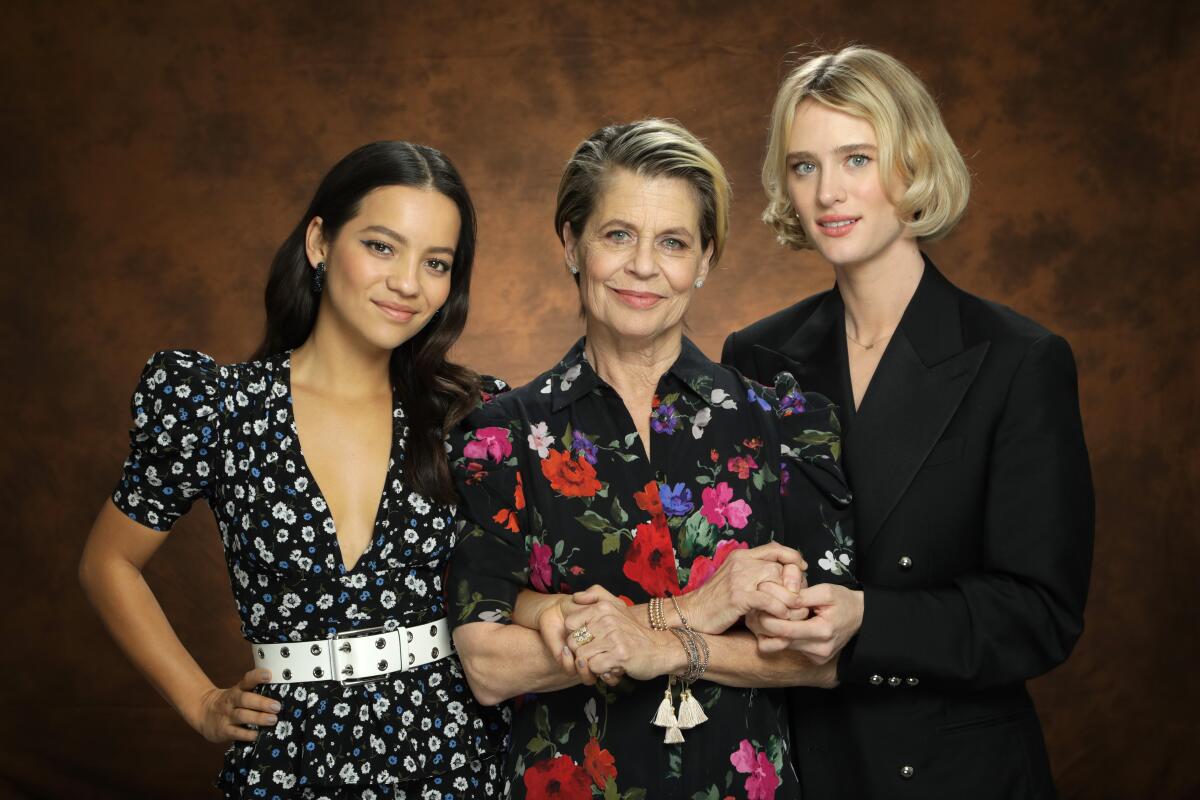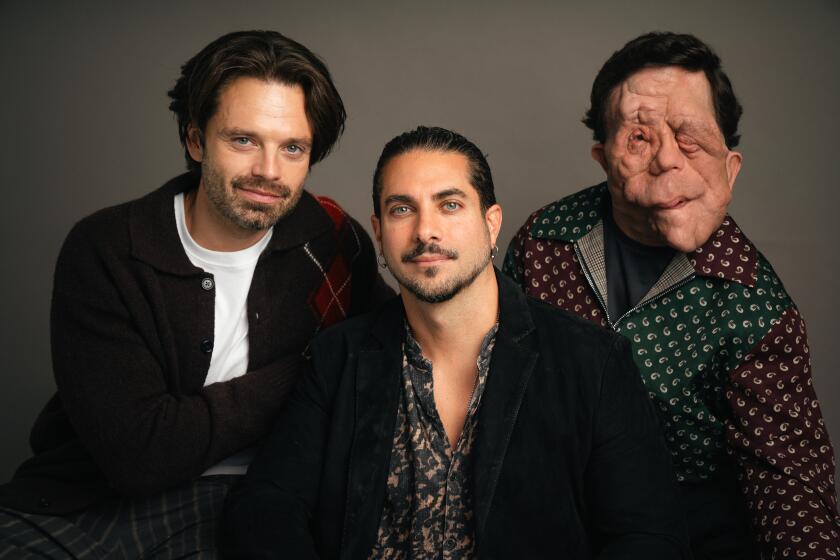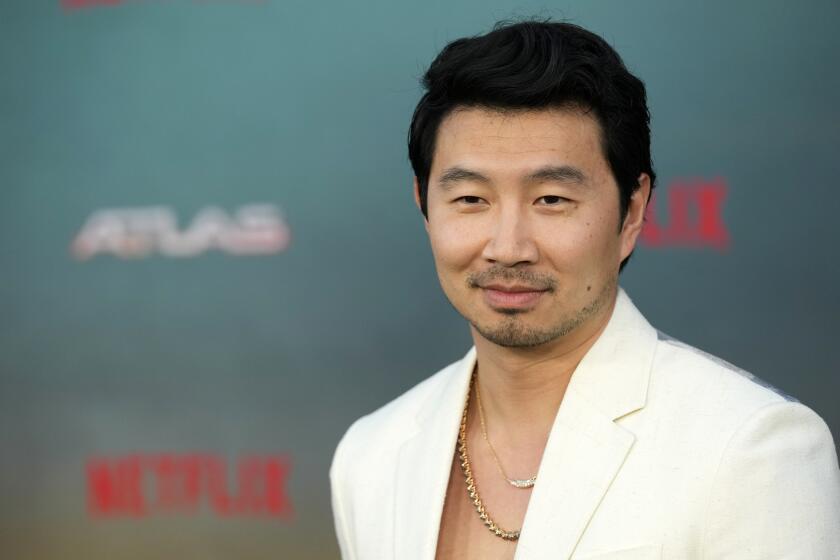How ‘Terminator: Dark Fate’ brought Sarah Connor back and made the future female
As that time-worn chestnut from the SkyNet future goes, there’s no fate but what we make.
Which is why, more than a quarter century after blasting her way to action icon status in 1991’s “Terminator 2: Judgment Day,” Linda Hamilton took a month and a half to decide if she should bring Sarah Connor back to the big screen for “Terminator: Dark Fate,” the sixth entry in the franchise.
Oscar-winning filmmaker James Cameron, director of the first two “Terminator” films, a producer on “Dark Fate” — and Hamilton’s former husband — had called three times. After the third call, she phoned him back.
“He said, ‘Limbo!’ We call each other Limbo and Jimbo,” explained Hamilton, who purposefully lives far away from Hollywood in New Orleans. “‘It’s about work.’”
He sent an email detailing pros and cons of why she should and shouldn’t reprise her signature character. Not that it mattered, Cameron said. “Anybody who knows Linda knows you don’t convince her of anything,” he said from New Zealand, where he’s filming his “Avatar” sequels. “It has to be her idea, or it has to be her decision.”
What was she mulling over in that time? “Did I want to switch out my lovely normal life in New Orleans for 15 more minutes of fame? Did I have anything to say as Sarah Connor that I hadn’t said already ... and could I possibly even do it again?” Hamilton recalled of the role she originated in 1984’s “The Terminator.”
In Los Angeles this week after the film’s globe-trotting press tour, she laughed. At 63, stepping back into the skin of a character built for pre-apocalyptic battle was an understandably daunting prospect. “I just didn’t want to let Sarah Connor down,” said Hamilton, who had a say on where the character went and where she’s been all these years, “and that really is my bottom line.”
Taking up Sarah Connor’s sinewy arms once again opposite Mackenzie Davis (“Halt and Catch Fire,” “Black Mirror: San Junipero”) and Natalia Reyes (“Birds of Passage”) in Nov. 1’s “Dark Fate,” Hamilton is now helping steer the “Terminator” universe into uncharted territory.
The first Arnold Schwarzenegger-Linda Hamilton reunion since “Terminator 2: Judgment Day” is a back-to-basics sequel with a few fresh wrinkles.
Reyes plays Dani Ramos, a Mexico City factory worker targeted by a time-traveling assassin from the future — not a T-1000, but an even slicker Rev-9 model (Gabriel Luna). Davis plays Grace, a tech-augmented soldier sent from the year 2042 to protect Dani, and who clashes with Hamilton’s now-grizzled and jaded Sarah Connor when the veteran warrior offers her help.
Arnold Schwarzenegger is back, too, as he always promised he would be, in a script written by David S. Goyer, Justin Rhodes and Billy Ray from a story by Goyer, Rhodes, Cameron, Charles Eglee and Josh Friedman.
It’s the Monday morning before “Dark Fate” opens nationwide and Hamilton has reunited for breakfast with Davis and Reyes at Culina in Beverly Hills. But first: the hugs. Hamilton is an avid hugger, and while bonding over a physically grueling shoot last year the trio grew close.

It’s also a bit of a bittersweet day. They’ve just gotten word that their premiere has been canceled because of the wildfires burning throughout Los Angeles, smoke from which you can smell in the autumn air as it drifts across the city. Earlier that morning, one such fire forced Schwarzenegger to evacuate his home before dawn.
“It’s such a state-of-the-world thing,” said Davis, 32, lacing things quickly into perspective. “The ‘Blade Runner’ premiere a few years ago was canceled because of the Las Vegas shooting. It’s guns and climate change, and you’ll cancel something or you’ll adjust the editing of a movie because of the timing of something, because it’s not right at the time.
“But you’re not fixing the root cause, which is, Oh, my God, the ... world is burning,” she added, Hamilton and Reyes nodding in agreement. “We have to leave this part of the world we’ve settled, and not just leave it, but correct the way that we’re treating the earth. It’s so scary.”
A well-known TV star in her native Colombia, Reyes, also 32, says she was intrigued but slightly skeptical when she heard a new “Terminator” film was in the works. She’d grown up watching the first two films, wanting to emulate Sarah Connor. Couldn’t Hollywood come up with new stories to tell? After self-taping for a secretive new role in “Dark Fate,” she flew to L.A. for her third callback, nerves jangling.
“I met this beautiful woman at the entrance, and she said, ‘Do you want water? You look great! You’re wonderful.’ And I thought, wow, that’s a nice producer!” said Reyes. “They’re usually like, ‘Come in, read, go.’ Then [director] Tim Miller came out and said, ‘Oh — you met Linda Hamilton!’”

They glanced at each other and laughed. “That was the best introduction to Linda,” said Reyes, who won the part after screen-testing an emotional character scene with Sarah Connor herself. “The first thing she would always do is hold your hand.”
“It’s just who I am,” shrugged Hamilton. Across the table, she’d already grabbed Reyes’ hand, holding it tenderly. “It’s certainly not in the scene!”
Prior to that moment she had no idea that Hamilton was reprising her famous role. She wouldn’t learn what Dani’s full arc was, or read a script, until later in the process. “It was love at first sight,” said Reyes. “I thought, ‘I don’t care if I don’t get the movie. This is my movie already.’”
Hamilton remembered testing with Reyes during the search for the pivotal part of Dani, a young woman who finds strength while navigating strangers want to both kill and protect her: “She left the room and I looked at Tim and said, ‘Bingo.’”
Davis found herself drawn to the challenge of Grace — committed, loyal, super strong, tactically nimble — a job requiring painstaking weapons and stunt training to pull off extensive firearm action, hand to hand combat, and one memorably lethal chain fight against the upgraded new Terminator.
During the months-long casting process, without a script yet to read, she relied on discussions and peeks at previsualization set pieces with director Tim Miller, the VFX pro who made his directorial debut with 2016’s “Deadpool,” to trust where “Dark Fate” was headed.
Importantly, she said, his approach to making a female-led “Terminator” film didn’t feel patronizing. “He wasn’t pitching it in that sort of [fake], trendy, ‘strong female character’ way, which I have such a radar for and hate so much, because it just makes you feel so disposable and temporary,” she said. “As if, ‘You’ll love this — she has a gun!‘”
“I think it’s cool in all the ‘Terminators’ and in our movie that we’re able to be protectors and warriors and heroes in a way that doesn’t require us to shed whatever female-ness there is about caretaking,” said Davis. “The look of [Grace] is almost masculine, but the way that I interact with Dani and our relationship feels distinctly female.”
They’re not that sort of old school, old form of ‘strong female characters.’ They feel like diverse, individual, human women.
— Mackenzie Davis
Directing from a script credited to six men, Miller says, he trusted that his stars knew their characters inside and out. “Mackenzie is very smart, she’s got a great ear for dialogue,” he said. “Natalia is also just an excellent actor and very tuned to the emotional experience that her character was going through. And Linda had all of those things — and she had this golden ticket from Jim where she didn’t have to say any line of dialogue she didn’t want to say.”
The ways in which Sarah, Dani and Grace interact onscreen, Davis says, feel nuanced as a result. “It wasn’t like, ‘They’re women … but they look and act like men!’” she said. “They’re not that sort of old school, old form of ‘strong female characters.’ They feel like diverse, individual, human women.”
In quieter moments, the film flirts with self-reflection as Sarah bristles at the perceived fate of women in her future — to bear the (male) savior of mankind, not be it.
“How it’s questioning itself, I think, is amazing,” said Reyes. “As women, we’re always serving other characters. We’re the lover, or the maid, or wife. I actually think ‘Terminator’ always was the story of Sarah Connor, not John Connor. It was always about her struggle to survive and get stronger and fight.”
In this timeline the Judgment Day of Sarah’s nightmares may have been averted, but new dangers loom. (The film, a direct sequel to “T2,” politely ignores the existence of the previous three sequels.) Bombastic set pieces fly fast and furious, including a siege on the auto factory where Dani and her brother work, a destructive high-speed freeway chase, a midair melee aboard a crashing C5 and an underwater assault that finds the heroines trapped inside a Humvee sinking beneath the Hoover Dam.
And while the central villain of the piece is a shape-shifting cyborg from the future, the fictional converges with the real world throughout “Dark Fate,” as in a lengthy sequence set inside a detention camp on the U.S.-Mexico border.
In Budapest, where “Dark Fate” was shot in addition to Spain and the U.S., extras playing migrants filled cages on a set that brought to life a vision eerily similar to those the cast and crew were seeing on the news. The first day there, Miller gave a tearful impromptu speech “to let everybody know that it was sensitive and how sensitive it was, and how painful it was to depict this reality for immigrants,” said Hamilton.
“I just felt that it needed to be acknowledged,” confirmed Miller by phone from Toronto. “I felt ashamed to be a part of a world where this was happening.” It was important to neither vilify the border agents nor the prisoners, he added.
[It] needed to be acknowledged. I felt ashamed to be a part of a world where this was happening.
— Director Tim Miller on the border detention set of “Terminator: Dark Fate”
“You know it’s happening and it’s a reality,” said Reyes, wearing a T-shirt emblazoned with three words: “I’m an immigrant.” “It just feels so inhuman and not right, and we were there and it was painful — even knowing that we were just doing a scene for a movie. I also love this about the movie. It’s not a movie about immigration, but it is a movie about reality and how the world is now.”
Many involved say the intention was not to make an overtly political “Terminator” sequel. Yet Cameron, who shepherded the storyline and recruited a writer’s room to chart out a potential three-film arc, delights in the pointed commentary.
“When you look at how Trump thinks of Mexico … it’s like, well, we’re going to tell a story about the most important person in the world,” he said. “She’s so important that they bend time to send an agent back to try to kill her to change the future. Let’s make her a Mexican national.
“Now you’ve got gender, but you’re also bringing race, culture and politics into it with that one decision. That’s absolutely by design, and that’s something that we talked about and we all leaned into,” he said. Adding not one but two female protectors in the forms of Sarah and Grace deepened that choice.
“Now you essentially have ‘The Sisterhood of the Traveling Pants’ with machine guns,” he said. “Did we think the world was hungry for a road movie with three women? I don’t know. It just seemed like a good idea to us.”
From where they were standing, however, the stars were in it to play complex characters, not emblems of some Hollywood vision of feminism. “At no point were we like, ‘Girls, can you believe it? THREE ladies in a movie?! We did it,’” said Davis. “I think things are meaningful when you don’t remind people of them all the time, when you’re not constantly applauding your own sense of progress. Because then it’s not progress.”
“But it’s still an event, you know?” added Reyes, who didn’t realize her character was such a major part of the story until she read the script for the first time on a plane to test with Davis. Hollywood’s track record with Latinx representation, after all, is one of the most dismal and disproportionate across all onscreen characters.
“I was like, ‘When am I going to die? I’m a Latino, we always die in the second scene,” said Reyes. “I was amazed. And I was like, ‘That’s [freaking] great.’ I didn’t grow up seeing that.”
“What will be truly progressive is when we don’t have to have the conversation at all because it’s just a natural, organic sort of thing,” offered Hamilton. “Our parts, each of them could have been played by a guy.”
What was it that Cameron wrote to Hamilton in that email more than two years ago, to encourage her to consider Sarah’s return?
“I said, there have been so many people that have tried to emulate what you did in that film, but by going after the physicality — missing the fact that it was a perfect blend of an extreme physicality and a really nuanced, dark, complex acted character,” said Cameron, who produced “Dark Fate” alongside David Ellison. “And I said, ‘And only you can do that.’ I also told her that, truthfully, we had no intention of trying to bring Sarah back if we couldn’t get Linda.”
It’s who Sarah has continued to evolve into within the world of “Terminator” that brought Hamilton back, she said. “Sarah is ever changing. I would not be interested in playing her if it was just a static story, but we deal with the consequences of our actions, and take journeys, and that’s what appeals to me.”
She thought back to the first “Terminator” movie, a gig that seemed like “just another movie, and a B movie at that” more than three decades ago. Then, she had no idea how her turn as a young waitress with the fate of the world on her shoulders would change her life and career.
“It was a slow burn,” she said with a laugh. “Nobody seemed to care! As a matter of fact, I was supposed to go on a press tour and at the last minute they canceled it because nobody wanted to talk to me. They only wanted Arnold. My New York trip was canceled because nobody cared.”
Across the table, the two women she calls her “dream team” smiled.
“What a difference 30 years makes,” said Davis.
More to Read
Only good movies
Get the Indie Focus newsletter, Mark Olsen's weekly guide to the world of cinema.
You may occasionally receive promotional content from the Los Angeles Times.











